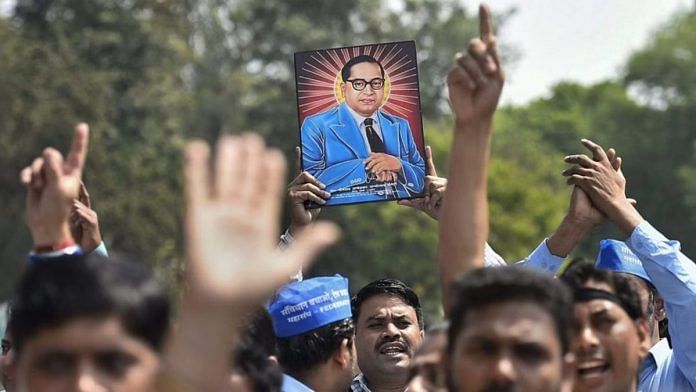A recent report by The News Minute sparked controversy by referring to Tamil Nadu and Kerala Chief Ministers MK Stalin and Pinarayi Vijayan as “Shudra” and “lowered caste” during their participation in an anti-caste event in Kerala. Many objected to the two terms, considering them to be derogatory and demeaning.
However, I don’t find anything objectionable about them.
In his 1946 book Who Were the Shudras, BR Ambedkar called social activist Jyotiba Phule — to whom he dedicated the book as well — “the greatest Shudra of Modern India”. According to Ambedkar, Phule “made the lower classes of Hindus conscious of their slavery to the higher classes and preached the gospel that for India, social democracy was more vital than independence from foreign rule”.
However, the term ‘Shudra’ has been used as a slur in Manusmriti, Ramcharitmanas and other Hindu texts. And in common parlance, it is used to insult or belittle someone.
I argue that language and its meanings evolve, and that truth and meaning are often context-dependent. I also explain which term I prefer and why.
I will address the second part of the question first.
Also read: How Dalit leaders created rift between Ambedkar’s savarna wife and son after he died
Mandal Commission, the gaze of language
In India, caste groups have been classified into various hereditary endogamous categories based on their social status and occupation. The Scheduled Castes (SC) and Scheduled Tribes (ST) have been recognised as the most marginalised groups and granted special protections under the Constitution. But these categories do not include all historically disadvantaged caste groups.
To address the issues faced by these groups, Article 340 of the Constitution recognises them as the Socially and Educationally Backward Classes (SEBC). The SEBCs are not considered ‘untouchables’ nor are they tribal. They are not part of the dominant castes who are now considered potential beneficiaries of the Economically Weaker Sections (EWS) reservation.
The Mandal Commission, formed in 1979, was tasked with identifying the SEBCs and recommending measures to improve their social and economic conditions. It used the phrase ‘Other Backward Classes’ or the OBCs for this section of people. Depending on the 1931 Census report, various surveys, and field studies, the commission estimated that these social groups constitute 52 per cent of India’s total population.
Based on the commission’s recommendations, the government introduced reservation for the OBCs in government jobs, educational institutions, and other public services. The OBCs are now recognised as a separate category under the Constitution and are entitled to various protections and benefits. The term OBC has also been constitutionally accepted, especially after related amendments. This is what I choose to call the social group that The News Minute described as “Shudras”.
Even before the Mandal Commission submitted its report, various states had demarcated these groups and BC (Backward Castes) — Pichda varg, Pichdi jaati, and so on.
It is true that many Dalit scholars, including activist and professor Kancha Ilaiah Shepherd, prefer the word “Shudra” to describe non-Savarna, non-SC/ST castes. It is also argued that most of those who took offence to the term are caste denialists.
However, this term is not normalised in states such as Tamil Nadu. Tamil anti-caste scholars prefer “lowered caste”. I would also prefer it instead of “lower caste” and “Shudra”, though OBC remains my first choice. I have five reasons why.
First, it’s about the gaze. The language we use to discuss caste-based issues can impact the way we view and understand the system’s dynamics. The term “lower caste” — and to some extent, Shudra — puts the gaze on the oppressed, implying that their caste status is responsible for their oppression. This language reinforces the idea that some castes are inherently inferior, perpetuating discrimination and inequality. But the term “lowered caste” puts the blame on the perpetrators and challenges the system’s enduring and entrenched nature, emphasising the need for social justice. Using such language promotes a more equitable and inclusive society.
Second, it recognises systemic injustice while situating it in history. Usage of the term ‘lowered caste’ recognises the systemic injustice that certain communities have faced in India. It emphasises the fact that the caste system has subjected some groups to marginalisation, discrimination, and violence. In contrast, ‘Shudra’ carries a complex religious-textual connotation, reinforcing the caste system’s hierarchical nature and implying that certain castes are inherently inferior.
Also read: Handling fake news—Tamil Nadu Police shows how it’s done. A template for other states’ forces
Third, it challenges the caste system hierarchy. It reframes the discussion away from the inherent inferiority of certain castes and toward systemic injustices. This is a crucial step to promote social justice and equality in India.
Fourth, ‘lowered castes’ promotes sensitivity and awareness about caste-based issues. And in doing so, the term promotes a more inclusive and equitable society where all individuals are treated with dignity and respect.
Lastly, it encourages responsibility and accountability for addressing caste-based discrimination and inequality. By placing the blame on the system, it points to a need for transformation.
In his writings, speeches, and movie scripts, former Tamil Nadu Chief Minister and Dravida Munnetra Kazhagam (DMK) leader, M Karunanidhi used the term பிற்படுத்தப்பட்டோர், which means that some caste groups became backward due to the actions of the others. This usage can settle the entire debate. Other languages must also find words with similar connotations.
To sum it all up, I borrow words from a tweet by Sudipto Mondal, the executive editor of The News Minute: “Our vocabulary is constantly evolving to reflect the aspirations of those who have been marginalised because of their caste, ethnicity, gender, religion, or sexuality by masculine ideologies.”
Dilip Mandal is the former managing editor of India Today Hindi Magazine, and has authored books on media and sociology. He tweets @Profdilipmandal. Views are personal.
(Edited by Ratan Priya)






